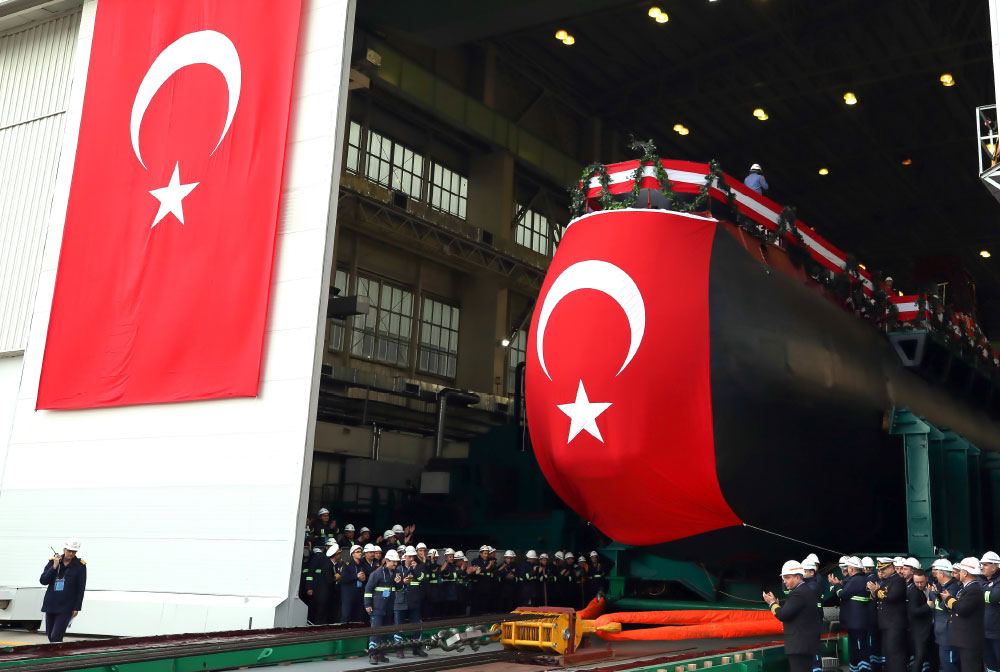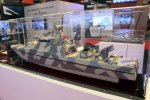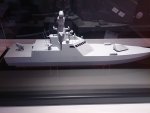Delivery schedule for New Type Submarine Project (NTSP) Contract which was signed on July 2nd 2009 has been effective started on June 22nd 2011. In this context, infrastructure activities and preparations related with submarine construction has been completed at Gölcük Naval Shipyard and the construction of the first submarine has been actually begun.

The launch ceremony of the TCG Piri Reis (S-330) Submarine, the first of the Type 214TN REIS Class Submarines being constructed at the Gölcük Naval Shipyard Command under the €2,060 Billion New Type Submarine Project (NTSP), was held on December 22, 2019, with the participation of President Recep Tayyip ERDOĞAN, Minister of National Defence Hulusi AKAR, Force Commanders and President of Defence Industries İsmail DEMİR. The keel of the TCG Seydi Ali Reis (S-334), the 5th Submarine of the Project, was also laid at the ceremony. In the next phase, the outfitting activities of the TCG Piri Reis Submarine will continue, and the submarine will enter service with the Turkish Navy in 2022 following the Factory Acceptance (FAT), Harbor Acceptance (HAT) and Sea Acceptance (SAT) Tests, respectively.
The Turkish Submarine Fleet has a long history spanning 134 years and has an indispensable place among world navies with its respectable traits and capabilities. With its modern vessels, the Submarine Fleet is one of the most vital combat elements that forges the striking force of the Turkish Navy. The Submarine Fleet Command currently operates a total of 12 submarines, including four AY Classes, four PREVEZE Classes, and four GÜR Classes. The Turkish Navy Submarine Fleet, which is always ready with 12 submarines, is an outstanding deterrent both in our region and worldwide...
To ensure the continued effectiveness of the Submarine Fleet in operational areas in the surrounding seas, the Turkish Naval Force Command (TNFC), seeing the need for modern submarines with quieter hull forms for reduced flow noise, the New Type Submarine Project was launched to acquire a variety of capabilities; an Air Independent Propulsion (AIP) System for long endurance underwater tasks, low acoustic, thermal and magnetic signatures, high capacity batteries, hybrid propulsion, and modern countermeasure systems. The administrative responsibility for this project was given to the Presidency of Defence Industries with the decision of the Defence Industry Executive Committee (DIEC/SSIK) dated June 22, 2005.
The €2,060 Billion New Type Submarine Project (NTSP) contract was signed between the SSB and German TKMS Joint Venture (formerly the HDW-MFI Joint Venture) on July 2, 2009 and entered into force on June 22, 2011. The project covers the construction of six Type 214TN Air Independent Propulsion (AIP) Submarines with the technical support and technology transfer to be provided by TKMS Joint Venture at the Gölcük Naval Shipyard Command, which has previously constructed 11 submarines (three AY, four PREVEZE, and four GÜR-Classes).
The construction of five submarines (the first steel plate of the 5th submarine was cut on December 22, 2019) is underway and the first submarine, TCG Piri Reis (S-330), was launched in December 2019 and will be commissioned with full operational capability in 2022. It will be followed by TCG Hızır Reis (S-331), TCG Murat Reis (S-332), TCG Aydın Reis (S-333), TGC Seydi Ali Reis (S-334) and TCG Selman Reis (S-335). The last submarine in the project will be delivered to the Turkish Naval Forces Command (TNFC) in 2027.
Initially, the class was to be called CERBE and was planned to be 66.3m long with a surface displacement of 1,845 tons. However, significant design modifications were made to meet Turkish Naval Forces Command (TNFC) requirements because of some technical problems with the HDW design, and Turkish engineers found five major design flaws and developed solutions for them. The resulting submarine, which is longer and heavier than CERBE, was renamed as REIS Class in 2014. However, the technical specifications of the REIS Class Submarines were revised, and the total length was increased again following the modifications. Additionally, the number of Cylindrical Metal Hydride Tanks (MHT) that are used to store Liquid Hydrogen, an essential element of the Air Independent Propulsion (AIP) System, has also been increased. The PEM (Polymer Electrolyte Membrane) Fuel Cells of the AIP System use pure hydrogen (H2) to generate power; however, pure hydrogen has toxic properties and is carried in cylindrical double-walled metal hydride tanks. Using seven rows of Cylindrical Metal Hydride Tanks instead of six rows in a CERBE Class design (Each carries a horizontally placed 15.3-ton capacity Liquid Oxygen [LOX] tank in its pressure hull) will considerably increase the amount of hydrogen carried in the Metal Hydride Tanks, which provide the necessary energy for the fuel cells used in the AIP System and will also increase the maximum amount of time that a submarine can stay underwater (Submerged Endurance). The Type 209PN and Type 214 Class submarines have six rows of metal hydride tanks (each row includes six cylinders, three on the right and three on the left) located outside the pressure hull in the bottom of the submarine hull while the Type 209 AIP submarines have five rows. However, the scale model of the Type 214TN New Type Submarine Project, which was revealed by TKMS for the first time at the 8th Naval Systems Seminar held in October 2017, has seven rows of metal hydride tanks outside the pressure hull. This means that REIS Class Submarines will have 6x7 = 42 metal hydride tanks. Before the second revision, the delivery schedule of the REIS Class Submarines was planned as 2021-2026 with a 12-month phase difference, while the new calendar was updated as 2022-2027.
While the height (13.1m/16.5m with the periscopes), width (6.3m), draught (6.8m) and the surface displacement (about 1,855 tons) of this new version, which we call REIS-II, didn’t change; the total length of the submarine was increased to 68.35m (0.75m longer than the first version of the REIS-Class and 2.05m longer than the CERBE Class). The submerged displacement of the submarine is around 2.050 tons. According to the TKMS product brochure, the total length of the new Type 214 Class submarines is 72m, and the surface displacement is about 2,000 tons.
On the other hand, the National Submarine (MILDEN), which will open a new page in the history of Turkish Submarines, is expected to enter service by the second half of the 2030s. Currently, the studies on the feasibility of MILDEN and the technical and operational characteristics of the submarine are continuing while the TNFC carries out manufacturability analysis for the MILDEN vessel. MILDEN will be built at the Gölcük Naval Shipyard Command, which has been doing overhauls of submarines in the TNFC service for 55 years and built submarines for 37 years. Gölcük Naval Shipyard Command is one of the 16 shipyards in the world that can build submarines.
Two BZM120 Proton-Exchange Membrane (PEM, also called Polymer Electrolyte Membrane) Fuel Cell modules (each generates 120kW power) lie at the heart of the Air Independent Propulsion (AIP) System of the Type 214 Class Submarines (the first batch of the U212A submarines and the first batch of the Type 214 boats ordered by the Republic of Korea Navy have 9 (one backup, eight active) BZM34 PEM modules that generate a total of 306kW (400hp) power). The service life of the BZ120 PEM Fuel Cell modules (each weighs 900kg, has a capacity of 500 liters and constitutes of 320 cells), is estimated between 2,000-4,000 hours. This means that after running 2,000-4,000 hours, the BZM120 PEM Fuel Cell modules will need to be replaced. The BZM120 PEM module enables the submarine to navigate at a cruising speed of 2 to 6kt (3.7 to 11.1km) and stay underwater without surfacing for about three weeks, depending on the speed. The Type 214 submarines can reach 12 knots on the surface and 22 knots while submerged. Thanks to its AIP System the submarines can stay underwater for 18 days (approximately 1,248nm/2,311km at 4 knots) without snorkeling to charge its batteries or can travel 12,000nm (2,311km) at 4 knots with maximum fuel and snorkeling.
The Type 214 submarine uses its diesel engines while cruising at high speeds and AIP System for low-speed silent cruising. The main components of the AIP System consist of the PEM Fuel Cell module, cylindrical metal hydride tubes, liquid oxygen tank, and control unit. The submarine can operate for an extended time without surfacing by using the electrical energy generated in the fuel cell module as a result of the chemical reaction between the liquid oxygen and the hydrogen stored in metal hydride tanks. Since the fuel cells use pure hydrogen to generate power, the module can continuously produce electricity as long as there is hydrogen feeding the system.

www.defenceturkey.com




















